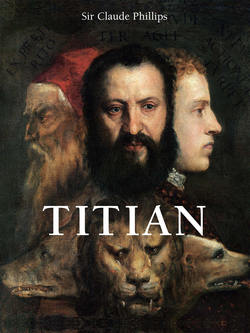Titian

Реклама. ООО «ЛитРес», ИНН: 7719571260.
Оглавление
Sir Claude Phillips. Titian
Introduction
The Earlier Work of Titian
The Later Work of Titian
Отрывок из книги
Titian (Tiziano Vecellio), Self-Portrait, 1565–1570.
Oil on canvas, 86 × 65 cm. Museo Nacional del Prado, Madrid.
.....
Other Venetian artists may, in one way or another, more irresistibly enlist our sympathies, or may shine out for the moment more brilliantly in some special branch of their art. Frequently, though, we still find ourselves invariably comparing them to Titian, not Titian to them; taking him as the standard for the measurement of even his greatest contemporaries and successors. Giorgione was of a finer fibre and, it could be said, more happily combined the subtlest qualities of the painter and the poet, in his creation of a phase of art of which the penetrating exquisiteness has never in the succeeding centuries lost its hold on the world. But then Titian, saturated with the Giorgionesque, and only marginally less the poet-painter than his master and companion, carried the style to a higher pitch of material perfection than its inventor himself had been able to achieve. The gifted but unequal Pordenone, who showed himself so incapable of sustained rivalry with our master in Venice, had moments of a higher sublimity that Titian did not reach until he came to the extreme limits of old age. This assertion is not a mere paradox, as the great Madonna del Carmelo at the Galleria dell’Academia and the magnificent Trinity in the sacristy of the Cathedral of San Daniele near Udine prove. Yet who would venture to compare him on equal terms to the painter of the Assunta, the Entombment and the Supper at Emmaus? Tintoretto, at his best, had lightning flashes of illumination, a titanic vastness, an inexplicable power of perturbing the spirit and placing it in his own atmosphere, which may cause the imaginative not altogether unreasonably to put him forward as the greater figure in art. All the same, if it were necessary to make a definite choice between the two, who would not uphold the saner and greater art of Titian, even though it might leave us nearer to reality, though it might conceive the supreme tragedies, not less than the happy interludes, of the sacred drama, in the purely human spirit and with the pathos of earth? A not dissimilar comparison might be made between the portraits of Lorenzo Lotto and those of Titian. No other Venetian painter had that peculiar imaginativeness of Lotto, which caused him to unconsciously infuse into it much of his own tremulous sensitiveness and charm, while seeking to penetrate into the depths of human individuality. In this way no portraits of the sixteenth century provide so fascinating a series of riddles. Yet in deciphering them it is necessary to take into account the peculiar temperament of the painter himself, as well as the physical and mental characteristics of the sitter and the atmosphere of the time.[2]
Finally, in the domain of pure colour some will deem that Titian has serious rivals in those Veronese who became Venetians: the elder Bonifazi and the younger Paolo Veronese. That is to say, there will be found lovers of painting who prefer a brilliant mastery over contrasting colours in frank juxtaposition to a relatively restricted palette, used with more subtle, if less dazzling art than theirs, and resulting in a deeper, graver richness. That is, a more significant beauty, if less stimulating in gaiety and variety of aspect. No less a critic than Morelli himself pronounced the elder Bonifazio Veronese to be the most brilliant colourist of the Venetian school, and Dives and Lazarus of the Galleria dell’Academia and the Finding of Moses at the Brera are at hand to give solid support to such an assertion.
.....